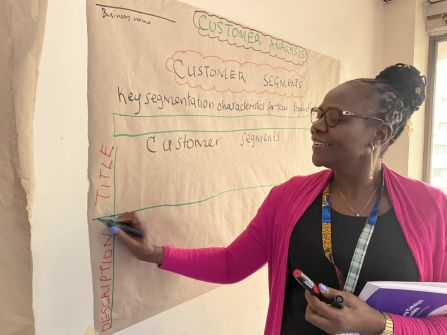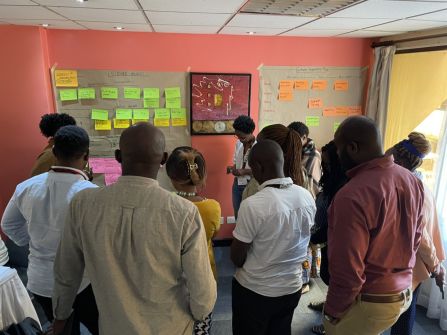Guiding the Transition
| Date |
Date
|
In June 2022, the Circular Economy Catalyst engaged 48 Business Development Support Providers (60% of which, female) in a training of trainers for early-stage enterprise support in the circular economy. Drawing insights from exchange during these sessions as well as from the newly adapted Circular Economy Catalyst Replicator toolkit and case studies, this article identifies key shifts in supporting circular businesses and tools for the future of business development support.

Small and medium enterprises (SMEs) form the backbone of the private sector in many countries, and are often at the forefront of innovating products and services needed in our societies. As what our societies value shifts, so too does the focus of business activities – to providing environmentally-friendly products to local and international markets, increasing social inclusion in the economy and, increasingly, to taking up an integral role in the transition to a circular economy.
As the SME sector shift their activities and missions, new and existing enterprises look for support to do so successfully. Crucial to their growth are two forms of support: 1) tailored and accessible financial instruments to support their growth, and 2) targeted business advisory that supports this transition. For the latter, business advisors must stay one step ahead, building experience in the tools, approaches and case studies necessary to guide the transition of SMEs – and the economy – towards circularity.
This raises important questions:
- What changes do circular approaches bring to conventional business development frameworks?
- What tools do business advisors need to support enterprises in this area?
As a starting point to answering these questions, this article outlines three key shifts that circularity brings to conventional business development approaches, and identifies tools that support these shifts.
The shift from customer- to user-centric business models
The common denominator of many critical success factors in building a business (targeted marketing, appropriate payment options, realistic sales projections, among others) is a strong understanding of the customer. A business must know its customer well – from her spending habits, communication preferences and interests, to how she perceives a brand, who influences her decisions, and how she might use a product or service.
Business models in the circular economy, however, may not centre on a customer that has a one-time engagement with the business to purchase a product or service. To maximise the value of resources in the ecosystem, circular businesses might adopt a user-based model, where the product is not bought by a customer, but the use of the product is provided as a service (e.g. in a bike sharing model). In this case, the business must consider the use of the products among their target group, and how a more continuous engagement of the user could be attained.
For this, business development support providers will need to support enterprises to consider scale – moving from analysing the experience of one customer purchasing a bike to multiple users purchasing the part-time use of a bike – and the implications of this shift on how they distribute their products, what payment options they make available, and how to market this service to their target group. Digitisation is likely to be a core tool in this support area, with platforms and apps are used to facilitate scale.
Key Tools: User Experience Journeys, Digitisation, Distribution Channels

In-depth value chain analysis helps to assess circularity
Analysing the value chain of a product or service yields multiple benefits: reducing cost inefficiencies, identifying resources needed, and assessing partnerships needed and impact at each stage. In a circular approach, the value chain analysis multiplies in importance. Alongside identifying opportunities to replace non-renewable inputs with renewable inputs, the value chain analysis supports enterprises to recognise by-products of their processes and brainstorm ways to close the loop, either within their own processes or by partnering with others. An example of this could be in the production of biofuels, where water that is a by-product of one step of manufacturing could be cleaned and reused.
The value chain analysis could be supported by a material flow analysis to increase circularity within an enterprise and to valorise by-products throughout business activities.
Key Tools: Value Chain Analysis, Impact Monitoring, Material Flow Analysis
Partnerships remain key to success
Engaging in the circular economy does not mean that a business must address all aspects of circularity within its own operations: rather, partnerships are an integral component of the circular economy. Ranging from partnerships for industrial symbiosis, partnerships with smallholder farmers for renewable agro-inputs, or partners in collecting and sorting waste, working with others will continue to play a role in implementation of the business mission. In many sectors of the circular economy, these partnerships may be with the informal sector – from repair shops operating informally, to e-waste pickers that provide casual labour without contracts. Business Development Support providers will need to support enterprises to navigate working with the informal sector, as well as how to formalise processes to ensure quality employment and payment records.
Key Tools: Partnership Compass, Network Expansion
With these shifts and tools, Business Development Support providers play a central role in guiding the transition to a circular economy. Do you have feedback on these shifts, or are you interested in future training of trainer programmes? If so, please reach out to us at bds thecircularcatalyst [dot] com (bds[at]thecircularcatalyst[dot]com)
thecircularcatalyst [dot] com (bds[at]thecircularcatalyst[dot]com)
